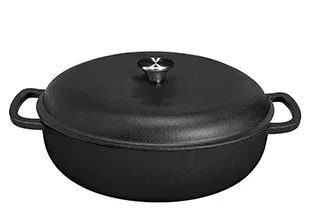
how to choose dutch oven size
How to Choose Dutch Oven Size
A Dutch oven is a versatile kitchen essential that can elevate your cooking game, whether you're making a hearty stew, baking bread, or slow-cooking a roast. However, with so many sizes available, it can be challenging to determine which one is right for your needs. In this article, we will explore the factors that can help you choose the perfect Dutch oven size for your culinary adventures.
1. Consider Your Cooking Needs
The first step in selecting the right size Dutch oven is to consider what types of dishes you plan to prepare. If you often cook for a large family or host gatherings, a larger Dutch oven (6 to 7 quarts) may be ideal. This size is perfect for making big batches of soups, stews, and casseroles. On the other hand, if you typically cook for yourself or a small family, a smaller model (3 to 5 quarts) will suffice for one-pot meals and side dishes.
2. Evaluate Your Kitchen Storage Space
Before making a purchase, it's essential to evaluate how much space you have in your kitchen for storage. Dutch ovens can be heavy and bulky, so you need to ensure that you have a dedicated spot for it in your cabinets or on your stovetop. If storage is limited, a smaller Dutch oven may be the practical choice. However, keep in mind that larger sizes can be more versatile, as they can accommodate bigger meals and even double as serving dishes.
3. Think About the Cooking Method
Different cooking methods may call for different sizes of Dutch ovens. For example, if you're baking bread, a 5.5-quart Dutch oven is often ideal, as it can hold a standard loaf while allowing enough room for proper heat circulation. Similarly, if you enjoy braising meats, consider a larger size (6 quarts or more) to ensure that there’s ample space for both the meat and accompanying vegetables without overcrowding the pot.
how to choose dutch oven size

4. Assess Your Meal Portions
Understanding your typical meal portions can significantly influence your choice. If you tend to cook large portions to last throughout the week, investing in a larger Dutch oven could save you time and effort in meal prep. Alternatively, if you prefer to cook smaller, fresh meals daily, a medium or smaller Dutch oven might be more practical.
5. Explore Material and Design
Dutch ovens come in various materials, including cast iron, enamel-coated cast iron, and ceramic. The size can also be influenced by the material itself, as some materials retain heat better than others. For example, a cast iron Dutch oven, regardless of size, will provide excellent heat retention and even cooking, making it a favored option among enthusiasts. Additionally, the design of the lid and pot shape can affect the cooking outcome, so consider these aspects while selecting the size.
6. Account for Price Factors
Finally, price can also be a determining factor. Larger Dutch ovens are typically more expensive than smaller ones. Although it’s important to consider your budget, remember that investing in a quality Dutch oven can pay off in terms of durability and cooking performance. If your budget allows, consider purchasing two sizes—one smaller for daily use and a larger one for special occasions.
Conclusion
Choosing the right Dutch oven size involves evaluating your cooking habits, kitchen space, and specific culinary needs. By taking these factors into account, you can find the perfect Dutch oven that will not only serve you well in your cooking endeavors but also enhance your overall culinary experience. Whether you're a novice cook or a seasoned chef, the right Dutch oven will become an invaluable addition to your kitchen arsenal. Happy cooking!
-
Season Cast Iron Perfectly with GPT-4 Turbo TipsNewsAug.01,2025
-
High Quality Cast Iron Cookware - Baixiang County Zhongda MachineryNewsAug.01,2025
-
Premium Cast Iron Pan: Durable & Perfect HeatNewsAug.01,2025
-
High Quality Kitchen Durable Black Round Cast Iron Cookware Pancake Crepe Pan-Baixiang County Zhongda Machinery Manufacturing Co., Ltd.NewsAug.01,2025
-
Cast Iron Cookware - Baixiang County Zhongda Machinery | Nonstick, Heat ResistanceNewsAug.01,2025
-
High Quality Kitchen Durable Black Round Cast Iron Cookware - Baixiang County Zhongda Machinery | Non-Stick, Heat Retention, DurableNewsJul.31,2025


